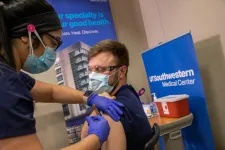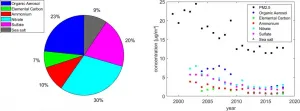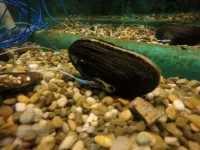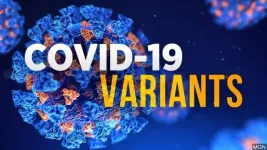New test traces DNA origins to monitor transplant rejection and reveal hidden cancers
A test that traces both the genetic and epigenetic origins of DNA in our blood could be used for prenatal genetic testing, monitoring transplant rejection and detecting hidden cancers
2021-03-23
(Press-News.org) A new technique that can trace which tissues and organs the DNA in our blood comes from has been reported today in the open-access eLife journal.
The method, called GETMap, could be used in prenatal screening, to monitor organ transplant rejection, or test for cancers that are concealed in the body.
"Analysis of circulating free DNA has been shown to be useful for screening for early asymptomatic cancers," explains first author Wanxia Gai, Postdoctoral Fellow at the Chinese University of Hong Kong, Hong Kong SAR, China. "As cancer-associated DNA changes are present in a wide range of cancer types, detection of such changes can be used as a universal test for concealed cancers. However, in patients with a positive test result, you still need to follow up with tests to find the tumour's location, for example, with a whole-body positron emission tomography, or PET, scan."
To address this, the team developed a test that looks for genetic differences, as well as epigenetic changes to DNA (changes which do not affect DNA sequences) known as methylation. The DNA in our cells has a unique methylation 'fingerprint'. Comparing the methylation fingerprints of different genetic types of DNA molecules circulating in the blood, for example molecules from a foetus, transplanted organ or tumour, with that of different tissues identifies where the DNA has come from.
The team first tested their approach in pregnant women, where they knew that blood DNA would include DNA from the mother, foetus, or both. As expected, GETMap found that DNA carrying foetus-specific genetic markers carried methylation signatures exclusively from the placenta. On the other hand, DNA molecules carrying mother-specific genetic markers carried methylation signatures from white blood cells. DNA molecules carrying genetic markers shared by both the mother and foetus were derived from both tissues.
Next, they tested the approach in blood donated by patients following a lung transplant. Detecting unusually high concentrations of DNA from a transplanted organ in blood can be a sign of organ rejection. But immediately after a transplant, there is often an unexplained surge in donor-derived DNA in the transplant recipient's blood. This makes it challenging to detect whether the organ is being rejected if only genetic markers are used. By using a combination of genetic and epigenetic markers, the team identified the origins of this surge in donor DNA. At 72 hours after transplantation, only 17% of the circulating DNA was from the lung, compared with 78% from blood cells. This surprisingly high contribution from the blood cells was likely due to the release of DNA from blood cells in the blood vessels of the transplanted lung. With time, the amount of circulating DNA from the lung increased, and the amount from blood cells decreased. There also seemed to be more donor lung DNA in the blood of patients whose new lungs were rejected, compared to those who had a successful transplant.
The team also tested whether GETMap could detect the origin of tumour-derived DNA in the blood. In two patients with liver cancer, they found that 90% and 87% of the plasma DNA carrying mutations had come from the liver. To test this, they needed to know the exact tumour mutations they were looking for, and tumour tissue is not always available if its location is unknown. The team therefore tried to use methylation fingerprints to identify cancer mutations directly from blood DNA rather than tumour tissue. Although fewer mutations were found, the liver was still correctly identified as the source of the tumour-derived molecules. This suggests GETMap could help to reveal the tissue and location of concealed cancers in people who have tumour markers in their blood.
Finally, they challenged the GETMap test in a woman who developed lymphoma during pregnancy. In this instance, they were able to distinguish between the foetal-specific genes which were derived from the placenta, and the tumour-specific genes which originated solely from a family of white blood cells that were related to the cell type of the lymphoma.
"We have demonstrated the powerful synergy between genetic and epigenetic approaches for identifying the origin of circulating DNA in the blood, and shown its potential applications in cancer screening, prenatal testing and organ transplant monitoring," says co-senior author Dennis Lo, Director of the Li Ka Shing Institute of Health Sciences, and the Li Ka Shing Professor of Medicine at the Chinese University of Hong Kong.
"Our test could bring us closer to the vision of a blood test for a universal cancer marker, by allowing more targeted follow-up tests in specific organs," concludes co-senior author Allen Chan, Professor of Chemical Pathology at the Chinese University of Hong Kong. "This could make cancer diagnosis earlier and more accurate, and reduce the use of whole-body scans and the associated exposure to radiation."
INFORMATION:
Media contact
Emily Packer,
Media Relations Manager
eLife
e.packer@elifesciences.org
+44 (0)1223 855373
About eLife
eLife is a non-profit organisation created by funders and led by researchers. Our mission is to accelerate discovery by operating a platform for research communication that encourages and recognises the most responsible behaviours. We aim to publish work of the highest standards and importance in all areas of biology and medicine, including Medicine, while exploring creative new ways to improve how research is assessed and published. eLife receives financial support and strategic guidance from the Howard Hughes Medical Institute, the Knut and Alice Wallenberg Foundation, the Max Planck Society and Wellcome. Learn more at https://elifesciences.org/about.
To read the latest Medicine research published in eLife, visit https://elifesciences.org/subjects/medicine.
ELSE PRESS RELEASES FROM THIS DATE:
2021-03-23
In a letter to The New England Journal of Medicine, published online March 23, 2021, a group of investigators from University of California San Diego School of Medicine and the David Geffen School of Medicine at UCLA report COVID-19 infection rates for a cohort of health care workers previously vaccinated for the novel coronavirus.
"Because of the compulsory daily symptom screening of health care personnel, patients, and visitors, and the high testing capacity at both UC San Diego Health and UCLA Health, we were able to identify symptomatic and asymptomatic infections among health care workers at our institutions," said co-author ...
2021-03-23
Boulder, Colo., USA: When geobiology graduate student Katie Maloney trekked into the mountains of Canada's remote Yukon territory, she was hoping to find microscopic fossils of early life. Even with detailed field plans, the odds of finding just the right rocks were low. Far from leaving empty-handed, though, she hiked back out with some of the most significant fossils for the time period.
Eukaryotic life (cells with a DNA-containing nucleus) evolved over two billion years ago, with photosynthetic algae dominating the playing field for hundreds of millions of years as oxygen accumulated in the Earth's atmosphere. Geobiologists think that algae evolved first in freshwater environments ...
2021-03-23
Over the past decades, the increased use of chemicals in many areas led to environmental pollution - of water, soil and also wildlife. In addition to plant protection substances and human and veterinary medical drugs, rodenticides have had toxic effects on wildlife. A new scientific investigation from scientists of the Leibniz Institute for Zoo and Wildlife Research (Leibniz-IZW), the Julius Kühn Institute (JKI) and the German Environment Agency (Umweltbundesamt - UBA) demonstrate that these substances are widely found in liver tissues of birds of prey from Germany. Anticoagulant rodenticides, commonly used to kill rodents in agriculture and forestry, were frequently detected, particularly in birds of prey close to or in urban environments. ...
2021-03-23
DALLAS - March 23, 2021 - Vaccinating health care workers resulted in an immediate and notable reduction of positive COVID-19 cases among employees, reducing the number of required isolations and quarantines by more than 90 percent, according to data at UT Southwestern Medical Center published in the New England Journal of Medicine.
Health care workers were among the first groups to be eligible for vaccination.
"Real-world experience with SARS-CoV-2 vaccination at UT Southwestern demonstrated a marked reduction in the incidence of infections among our employees, preserving the workforce when it was most needed," notes Daniel K. Podolsky, M.D., president of UT Southwestern and senior author.
During ...
2021-03-23
ITHACA, N.Y. - New research from Mildred Warner, professor of city and regional planning at Cornell University, shows that state laws designed to hinder union activity and indulge corporate entities do not enhance economic productivity.
"We find that where state policy is captured by corporate interests, this undermines inclusive growth," Warner said. "These interests see union and city power as a threat, which is why there are groups like the American Legislative Exchange Council, for example, focused on crafting state laws that erode labor protections and enhance corporate interests."
The ...
2021-03-23
California's restrictions on vehicle emissions have been so effective that in at least one urban area, Los Angeles, the most concerning source of dangerous aerosol pollution may well be trees and other green plants, according to a new study by University of California, Berkeley, chemists.
Aerosols -- particles of hydrocarbons referred to as PM2.5 because they are smaller than 2.5 microns in diameter and easily lodge in the lungs -- are proven to cause cardiovascular and respiratory problems.
As a result of strict vehicle emissions laws, organic aerosol levels have been significantly reduced throughout the United States, but the drop has been particularly dramatic ...
2021-03-23
Understanding the evolution of the polar sea ice is not enough to study the effects of the climate change on marine ecosystems in Antarctic seafloors. It is also necessary to determine the intensity of phytoplankton local production during the Antarctic summer, as stated in a new study by a research team of the Faculty of Biology and the Biodiversity Research Institute (IRBio) of the University of Barcelona, published in the journal Marine Environmental Research.
When the sea freezes in Antarctica
Extremely low temperatures, strong ocean currents and the broad seasonal coverage of marine ice are factors that determine the features of the Antarctic marine ecosystems. IN particular, the seasonality ...
2021-03-23
The rate of sea-level rise in the 20th century along much of the U.S. Atlantic coast was the fastest in 2,000 years, and southern New Jersey had the fastest rates, according to a Rutgers-led study.
The global rise in sea-level from melting ice and warming oceans from 1900 to 2000 led to a rate that's more than twice the average for the years 0 to 1800 - the most significant change, according to the study in the journal Nature Communications.
The study for the first time looked at the phenomena that contributed to sea-level change over 2,000 years at six sites along the coast (in Connecticut, New York City, New Jersey and North Carolina), using a sea-level budget. A budget enhances ...
2021-03-23
Researchers at North Carolina State University have designed and demonstrated a new system that allows them to remotely monitor the behavior of freshwater mussels. The system could be used to alert researchers to the presence of toxic substances in aquatic ecosystems.
"When mussels feed, they open their shells; but if there's something noxious in the water, they may immediately close their shells, all at once," says Jay Levine, co-author of a paper on the work and a professor of epidemiology at NC State. "Folks have been trying to find ways to measure how widely mussels or oysters open their shells off and on since the 1950s, but there have been a wide variety ...
2021-03-23
All viruses mutate as they make copies of themselves to spread and thrive. SARS-CoV-2, the virus the causes COVID-19, is proving to be no different. There are currently more than 4,000 variants of COVID-19, which has already killed more than 2.7 million people worldwide during the pandemic.
The UK variant, also known as B.1.1.7, was first detected in September 2020, and is now causing 98 percent of all COVID-19 cases in the United Kingdom. And it appears to be gaining a firm grip in about 100 other countries it has spread to in the past several months, including France, Denmark, and the United States.
The World Health Organization says B.1.1.7 is one of several variants of concern along with others that have emerged in South Africa and Brazil.
"The UK, ...
LAST 30 PRESS RELEASES:
[Press-News.org] New test traces DNA origins to monitor transplant rejection and reveal hidden cancers
A test that traces both the genetic and epigenetic origins of DNA in our blood could be used for prenatal genetic testing, monitoring transplant rejection and detecting hidden cancers







